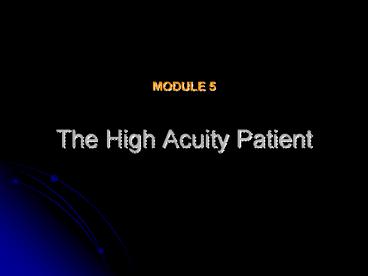The High Acuity Patient - PowerPoint PPT Presentation
1 / 34
Title:
The High Acuity Patient
Description:
Evidence in septal, anterior, and lateral leads. Often from ... Mid-scapular line. Level with V6. V9. Left para-vertebral. Level with V6. Posterior Wall ... – PowerPoint PPT presentation
Number of Views:85
Avg rating:3.0/5.0
Title: The High Acuity Patient
1
The High Acuity Patient
MODULE 5
2
Coronary Artery Anatomy
- Varies from patient to patient
- General patterns of distribution exist
3
Left Coronary Artery
Left Main
Right Coronary Artery
Left Circumflex
Right Ventricle
Lateral Wall
Septal Wall
Anterior Wall
Anterior Descending Artery
4
Left Coronary Artery (LCA)
- Left Main (proximal LCA)
- Left Circumflex (LCX)
- Left Anterior Descending (LAD)
5
Distribution
- LAD anteroseptal
- LCX lateral
- Proximal LCA extensive anterior
6
Practice ECG
7
Practice ECG
8
Practice ECG
9
Extensive Anterior MI
- Evidence in septal, anterior, and lateral leads
- Often from proximal LCA lesion
- Widow Maker
- Complications common
10
Definitive Therapy for Extensive AWMI
- Normal blood pressure
- Thrombolysis
- Signs of shock
- PTCA
- CABG
11
LCA Occlusions
- Other considerations
- Bundle branches supplied by LCA
- Serious infranodal heart block may occur
12
Right Coronary Artery
Left Coronary Artery
Right Coronary Artery
Lateral Wall
Posterior Descending Artery
Left Ventricle
Posterior Wall
Inferior Wall
13
Right Coronary Artery (RCA)
- Proximal RCA
- Posterior descending artery (PDA)
14
RCA Distribution
- Proximal RCA
- Right ventricle
- Posterior wall
- Inferior wall
- PDA
- Inferior wall
15
Practice ECG
16
Proximal RCA Occlusion
- Right Ventricular Infarct (RVI)
- 12-lead ECG does not view right ventricle
- Use additional leads
- V3R - V6R
- V4R
17
Right Precordial Leads
- On right side of chest
- Same anatomical landmarks as V3 - V6
18
Practice ECG
19
ECG Evidence of RVI
- Inferior MI (always suspect RVI)
- ST elevation right V leads
20
Cardiac Blood Flow
To Lungs
From Lungs
To Body
From Body
21
Physical Evidence of RVI
- Dyspnea with clear lungs
- Jugular vein distension
- Hypotension
- Relative or absolute
22
Treatment for RVI
- Use caution with vasodilators
- Small incremental doses of MS
- NTG by drip
23
Fluid for Hypotension
- One to two liters may be required
- Large bore lines suitable here
24
Posterior Wall MI (PWMI)
- Usually an extension of an inferior or lateral MI
- Common with proximal RCA occlusions
- Occurs with LCX occlusions
25
PWMI
- Reciprocal changes
- V1 - V4
- Indicative changes
- V7, V8, V9
26
Posterior Leads
- V7
- Posterior axillary line
- Level with V6
- V8
- Mid-scapular line
- Level with V6
- V9
- Left para-vertebral
- Level with V6
27
Indicative Leads
Infarcted Tissue
Posterior Wall
Ischemic Tissue
Reciprocal Leads
28
PWMI
- Best to identify with direct leads
- V7, V8, V9
- ST elevation in posterior leads is evidence of
posterior MI
29
Practice ECG
30
PWMI
- Look for PWMI when
- V1 -V4 show ST depression
- The ECG is normal
- The story is convincing
31
Left Coronary Dominance
- Approximately 10 of population
- LCX supplies PDA
- Inferolateral MI
32
Dominant Left Coronary
- Left circumflex supplies posterior descending
artery
33
Practice ECG
34
Lab for Module 5
- Lab manual

